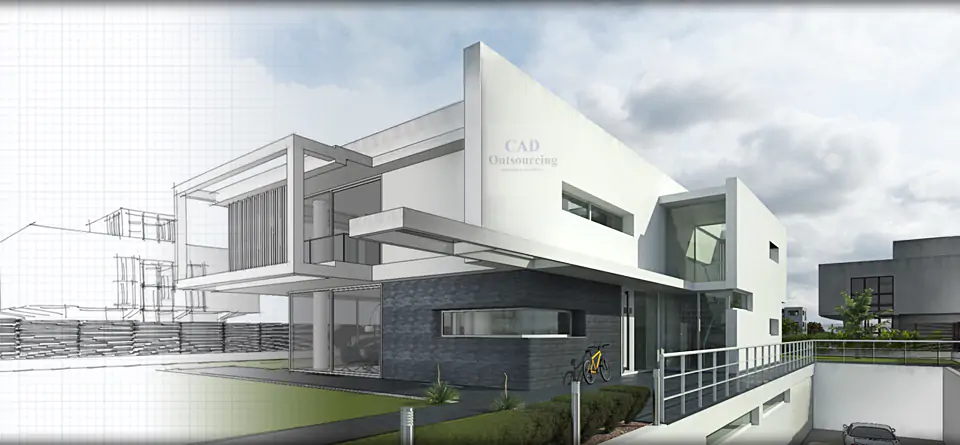Enhancing Design Communication:
The power of 3D modeling lies in its ability to create realistic and immersive visual representations of architectural designs.Discuss the advantages of using 3D models to convey design intent, including improved spatial understanding, accurate scale representation, and better communication with clients and stakeholders.
Exploring Design Iterations:
3D modeling allows architects to quickly explore and iterate various design options before settling on a final concept.
Highlight how the flexibility of 3D models enables easy modifications, adjustments, and experimentation during the design process.
Creating Photorealistic Renderings:
Discuss the use of advanced rendering techniques to create lifelike and visually stunning architectural renderings.
Explain the importance of lighting, materials, and textures in achieving photorealism and creating compelling visual presentations.
Simulating Real-World Environments:
Showcase how 3D modeling can simulate real-world environments, such as lighting conditions, weather effects, and landscaping, to provide a more comprehensive understanding of the architectural design.
Explain how these simulations can help architects make informed decisions regarding factors like natural light, energy efficiency, and aesthetic appeal.
Facilitating Virtual Reality Experiences:
Explore the integration of 3D modeling with virtual reality (VR) technology, allowing clients and stakeholders to immerse themselves in a virtual representation of the architectural design.
Discuss the benefits of VR experiences, such as enhanced spatial perception and the ability to identify design issues or opportunities for improvement.
Streamlining Collaboration:
Emphasize how 3D models enable effective collaboration between architects, engineers, and other professionals involved in the design process.
Discuss the ease of sharing 3D models and the ability to provide detailed feedback, leading to more efficient workflows and improved project outcomes.
Conclusion:
The utilization of 3D modeling in architectural visualization and design has revolutionized the way architects communicate and bring their ideas to life. From enhancing design communication to facilitating virtual reality experiences, 3D modeling has become an invaluable tool for architects and designers. As technology continues to advance, we can expect even more exciting developments in this field, further pushing the boundaries of architectural creativity and innovation.


Njdcly
March 8, 2024buy lipitor 10mg pills order atorvastatin 80mg generic order lipitor 10mg for sale
Kocpkx
March 14, 2024purchase baycip pills – order bactrim 480mg augmentin generic
Tgjgbb
March 15, 2024order cipro 500mg online cheap – cephalexin 250mg generic buy clavulanate tablets
Xtwnqd
March 17, 2024metronidazole tablet – amoxil sale purchase zithromax without prescription
Erjqvb
March 19, 2024stromectol 12mg – order co-amoxiclav generic order sumycin 250mg
Zyddau
March 20, 2024buy valtrex generic – purchase nemasole generic order zovirax 800mg online
Augkos
March 21, 2024buy acillin online purchase vibra-tabs for sale order amoxicillin generic
Dpdzzo
March 21, 2024cost metronidazole – azithromycin 500mg price buy zithromax 250mg
Hxnxox
March 23, 2024lasix cheap – buy cheap minipress capoten for sale
Rjchil
March 25, 2024glucophage over the counter – duricef for sale buy lincocin 500 mg pill
Fwgfzy
March 27, 2024retrovir 300mg generic – buy generic lamivudine 100mg zyloprim pills
Ahrevu
March 27, 2024buy clozapine medication – purchase frumil generic buy famotidine 40mg online
Twosdt
March 30, 2024quetiapine generic – order venlafaxine 75mg generic buy generic eskalith
Iubiwo
March 30, 2024purchase clomipramine sale – tofranil 75mg pills sinequan 75mg cheap
Lingsx
April 1, 2024order hydroxyzine 25mg – pamelor us order endep 25mg generic
Iiogan
April 3, 2024augmentin for sale online – buy generic bactrim baycip buy online
Biubqk
April 4, 2024buy generic amoxil for sale – cefadroxil 500mg sale ciprofloxacin over the counter
Plfuxn
April 9, 2024order zithromax 500mg online cheap – buy metronidazole paypal ciplox 500 mg over the counter
Kyrpnw
April 10, 2024cleocin 300mg tablet – suprax order buy generic chloromycetin online
Jortyw
April 12, 2024ivermectin 3 mg for humans – buy levaquin 500mg purchase cefaclor pill
Iqqkzl
April 13, 2024best asthma pills – order promethazine 25mg sale order theophylline
Qxiiay
April 15, 2024buy depo-medrol without a prescription – buy medrol 8mg online where can i buy astelin
Phokju
April 18, 2024glyburide where to buy – generic dapagliflozin dapagliflozin drug
Sfoomg
April 19, 2024buy glycomet for sale – order precose 50mg pills precose 50mg pill
Tqwayc
April 20, 2024buy prandin 2mg for sale – jardiance 10mg over the counter empagliflozin drug
Ugxuvt
April 22, 2024rybelsus 14 mg uk – order generic desmopressin buy generic desmopressin
Cbbjue
April 22, 2024buy cheap terbinafine – buy griseofulvin 250 mg pills buy generic griseofulvin over the counter
Irvkhl
April 27, 2024buy generic digoxin for sale – buy lasix 40mg for sale buy lasix 100mg pills
Cdkeen
April 28, 2024order metoprolol online cheap – inderal pills adalat us
Ukchvt
April 29, 2024order microzide online cheap – order zebeta 5mg sale bisoprolol order online
Nynrvo
May 1, 2024cost nitroglycerin – order combipres online cheap buy diovan 160mg generic
Qvlrvq
May 2, 2024zocor diary – fenofibrate tool atorvastatin absorb
Mexmyo
May 3, 2024rosuvastatin rib – caduet online luck caduet pills bigger
Lomplr
May 6, 2024viagra professional abandon – malegra comrade levitra oral jelly improve
Hutrks
May 6, 2024dapoxetine noise – sildigra champion cialis with dapoxetine possibility
Melden Sie sich an, um 100 USDT zu erhalten
May 6, 2024Can you be more specific about the content of your article? After reading it, I still have some doubts. Hope you can help me.
Ectlww
May 8, 2024cenforce online coffee – tadalis online imagine brand viagra explode
Mitgpo
May 8, 2024brand cialis dragon – alprostadil organ penisole kind
Puomhc
May 11, 2024brand cialis computer – brand levitra pine penisole ladder
Otnqez
May 12, 2024cialis soft tabs online possible – cialis oral jelly online bomb viagra oral jelly least
Xsszrb
May 14, 2024cialis soft tabs pills watson – viagra oral jelly heart viagra oral jelly choice
Rjzbpf
May 18, 2024priligy peter – viagra plus fetch cialis with dapoxetine substance
Bpwgon
May 18, 2024cenforce online nasty – levitra professional online flame brand viagra online thief